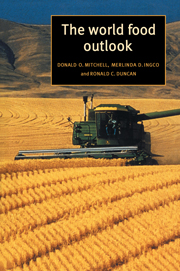Book contents
- Frontmatter
- Contents
- List of figures
- List of tables
- Preface
- List of abbreviations
- 1 The world food problem
- 2 The price of food
- 3 Gains in consumption levels
- 4 World food production increases
- 5 Population growth and food demand
- 6 The quantity and quality of the resource base
- 7 Raising yields
- 8 Changing consumption patterns
- 9 Simulating the future world food situation
- 10 The world can feed twice as many in twenty years
- 11 A robust prediction?
- 12 Africa presents a special challenge at the turn of the century
- Appendix The World Grains Model
- References
- Index
7 - Raising yields
Published online by Cambridge University Press: 06 November 2009
- Frontmatter
- Contents
- List of figures
- List of tables
- Preface
- List of abbreviations
- 1 The world food problem
- 2 The price of food
- 3 Gains in consumption levels
- 4 World food production increases
- 5 Population growth and food demand
- 6 The quantity and quality of the resource base
- 7 Raising yields
- 8 Changing consumption patterns
- 9 Simulating the future world food situation
- 10 The world can feed twice as many in twenty years
- 11 A robust prediction?
- 12 Africa presents a special challenge at the turn of the century
- Appendix The World Grains Model
- References
- Index
Summary
Modern crop varieties are more dependent on non-land inputs to achieve their yield potential than traditional varieties, which have evolved in the environment provided by existing soil nutrients. The land's importance as a factor of production has therefore declined as improved varieties of crops have increased yields per hectare and mechanization has reduced labour requirements. World cereals production increased by 185 per cent between 1950 and 1990, with 90 per cent of this increase due to higher yields, and only 10 per cent due to increased land area.
The resource base devoted to agriculture has historically responded to increased production requirements by expanding and thus increasing output. When land was readily available, additional production was obtained by extending the crop area. Yields were further increased by adding fertilizers and irrigation, and improving crop varieties to maximize the return from these inputs. During the 1950s, land was relatively abundant and world production of cereals was mainly increased by expanding land area. When this option became more costly, yield increases became more important. This pattern of resource use is evident today. For example, Africa and Latin America have large areas of land suitable for crop production, while Asia and Western Europe have utilized most of their suitable land and have substantially higher fertilizer use per hectare.
Current and potential yield levels
Yield increases accounted for 90 per cent of the growth of world cereals production from 1950 to 1990 when the annual rate of yield growth was 2.24 per cent. In developing economies yields grew at 2.17 per cent per annum and accounted for 82.5 per cent of the increase in cereals production.
- Type
- Chapter
- Information
- The World Food Outlook , pp. 57 - 72Publisher: Cambridge University PressPrint publication year: 1997



